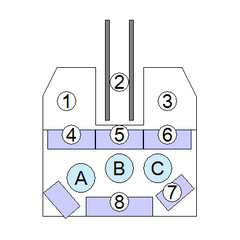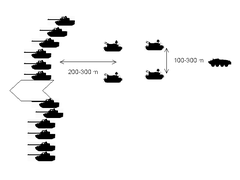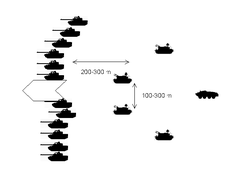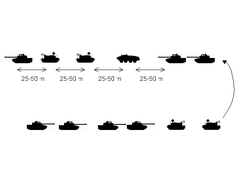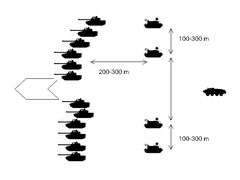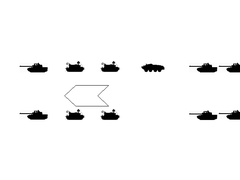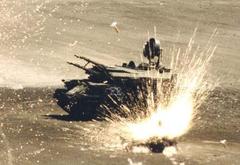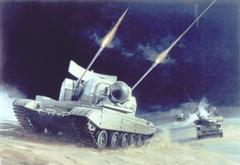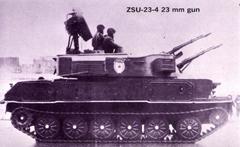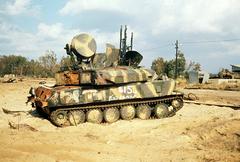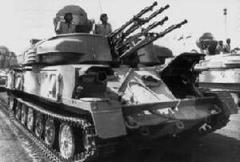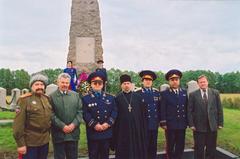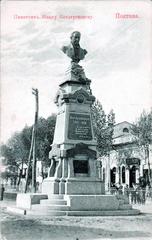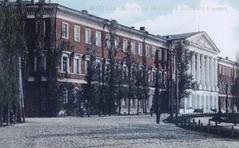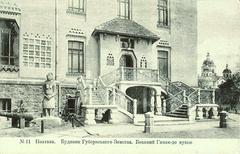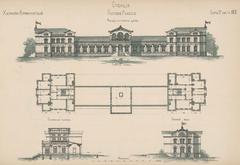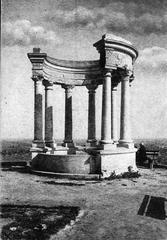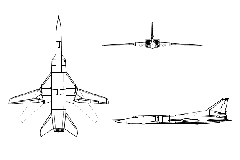
ZSU-23-4 Shilka Poltava Visiting Hours, Tickets, and Visitor Guide
Date: 14/06/2025
Introduction
The ZSU-23-4 Shilka is a landmark of Cold War military engineering and a powerful symbol of both Soviet-era innovation and contemporary Ukrainian resilience. Today, this self-propelled anti-aircraft gun draws visitors to the Museum of Military Conflicts of the XX Century in Poltava, Ukraine, where it stands as a testament to decades of technological progress, battlefield adaptability, and historical significance. Whether you are a military history enthusiast, a student, or a curious traveler, the Shilka exhibit offers a comprehensive educational experience and a direct connection to pivotal moments in 20th and 21st-century warfare (GlobalSecurity.org; Warfare History Network).
Contents
- Introduction
- Historical Background of the ZSU-23-4 Shilka
- The Shilka’s Role in Military History
- The Shilka in Ukrainian Service and the Poltava Exhibit
- Technical Features and Capabilities
- Visitor Guide: Location, Hours, and Accessibility
- Museum Experience and Travel Tips
- Cultural and Educational Importance
- Frequently Asked Questions (FAQ)
- Conclusion and Recommendations
- Sources and Further Reading
Historical Background of the ZSU-23-4 Shilka
Developed by the Soviet Union in the late 1950s and entering service in 1965, the ZSU-23-4 “Shilka” revolutionized mobile air defense for armored and mechanized units. Integrating four 23mm autocannons with a radar-guided fire control system, it provided an unprecedented combination of firepower and accuracy, specifically targeting low-flying aircraft and helicopters. The vehicle’s name—“ZSU” (Zenitnaya Samokhodnaya Ustanovka, or anti-aircraft self-propelled mount), “23” (the caliber in millimeters), and “4” (the number of barrels)—reflects its formidable design (Wikipedia; GlobalSecurity.org).
During its extensive service, the Shilka saw combat in multiple conflicts, such as the Yom Kippur War and the Soviet-Afghan War, earning a reputation for reliability and effectiveness. Its rapid-fire autocannons and radar targeting systems forced enemy pilots to adapt their tactics, substantially shaping NATO and Warsaw Pact air doctrines (Warfare History Network).
The Shilka’s Role in Military History
Cold War and Beyond
The Shilka quickly became a staple of Soviet and Warsaw Pact motorized rifle and tank regiments, with more than 6,500 units produced. Its ability to track and engage fast-moving aerial threats made it a pivotal asset on the battlefield. In Afghanistan, for example, variants without radar were deployed for enhanced ammunition capacity and ground fire support (GlobalSecurity.org).
Influence on Modern Air Defense
While newer systems like the 2K22 Tunguska and Pantsir-S1 have since entered service, the Shilka’s basic design principles—combining radar-guided cannon fire with mobility—remain influential. Its presence on modern battlefields, especially through upgrades and adaptations, demonstrates the enduring utility of legacy air defense systems (GlobalSecurity.org).
The Shilka in Ukrainian Service and the Poltava Exhibit
Recent Deployments
Ukraine inherited a significant number of Shilkas after the Soviet Union’s dissolution. These vehicles were refurbished and, in response to evolving threats such as drones, returned to active service. Notably, in 2022, Poland supplied Ukraine with additional Shilka units, reinforcing their ongoing operational relevance during contemporary conflicts (Militarnyi.com; Army Recognition).
The Poltava Shilka as a Symbol
The preserved Shilka at the Museum of Military Conflicts of the XX Century in Poltava stands on a prominent stone pedestal, serving as both a historical artifact and a modern emblem of Ukraine’s defense resilience. It links the city’s local heritage with broader military narratives, offering visitors a tangible connection to both past and present (Visit Poltava).
Technical Features and Capabilities
- Armament: Four 23mm 2A7 autocannons, up to 4,000 rounds per minute combined rate of fire. Effective aerial range: ~2.5 km; maximum engagement altitude: 1.5 km (MilitaryFactory.com).
- Radar: RPK-2 “Tobol” system, with search range up to 20 km for large aircraft and tracking range of 18 km. Optical sight provided for ground targets or ECM-heavy environments (Weaponsystems.net).
- Mobility: Tracked chassis, 280 hp diesel engine, max speed 50 km/h, operational range ~450 km.
- Protection: Steel armor (small arms and shell fragments), NBC protection system.
- Crew: Four (driver, commander, gunner, radar operator). Modernized variants may have reduced crew and improved features (Militarnyi.com).
- Limitations: Vulnerable to heavy weapons, limited armor, radar susceptible to ECM, ammunition capacity constraints. Some upgrades include digital fire control and night vision (GlobalSecurity.org).
Visitor Guide: Location, Hours, and Accessibility
Location
- Museum: Museum of Military Conflicts of the XX Century, Poltava, Ukraine (Visit Poltava)
- Address & Contact: Centrally located; +38 (0532) 56 62 44
Visiting Hours & Tickets
- Hours: Tuesday–Sunday, 10:00 AM–5:00 PM (closed Mondays; hours may vary, confirm in advance)
- Admission: Free of charge for both museum and outdoor Shilka exhibit
Accessibility
- Outdoor Shilka display is wheelchair accessible.
- The museum provides assistance for visitors with disabilities; contact in advance for support.
Museum Experience and Travel Tips
- Exhibits: In addition to the Shilka, the museum displays mines, small arms, documents, uniforms, and personal memorabilia from various conflicts, with many artifacts donated by veterans (Visit Poltava).
- Tours: Thematic guided tours and documentary screenings are available, offering in-depth insight into military history and technology.
- Photography: Outdoor photography is permitted; check with staff for indoor exhibit policies.
- Travel: The museum is accessible by local buses, taxis, or car, with parking nearby.
- Best Time to Visit: Late spring to early autumn for pleasant weather and outdoor exploration.
- Nearby Attractions: Explore Poltava’s other historical sites, including WWII memorials and regional museums.
Cultural and Educational Importance
The ZSU-23-4 Shilka monument in Poltava is more than a relic; it is a living artifact embodying decades of military innovation and adaptation. The exhibit offers interpretive materials and multimedia resources, helping visitors understand the evolution of air defense, the human stories behind the technology, and the broader context of Ukraine’s military heritage. The continued operational relevance of the Shilka—particularly against modern threats like drones—underscores the dynamic relationship between history and current events (Gunpowder Magazine).
Frequently Asked Questions (FAQ)
Q: What are the visiting hours for the ZSU-23-4 Shilka?
A: Tuesday–Sunday, 10:00 AM–5:00 PM. Confirm current hours with the museum or Poltava City Council.
Q: Is there an admission fee?
A: No, admission to the museum and the outdoor Shilka exhibit is free.
Q: Are guided tours available?
A: Yes, thematic guided tours are offered. Inquire at the museum for schedules.
Q: Is the site accessible for visitors with disabilities?
A: Yes, both the outdoor and museum exhibits are accessible; contact ahead for specific needs.
Q: Can I take photographs?
A: Yes, photography is permitted outdoors. Check with staff for indoor policies.
Q: How do I get there?
A: The museum is centrally located and accessible by public transport, taxi, or car.
Conclusion and Recommendations
Visiting the ZSU-23-4 Shilka monument in Poltava provides a unique opportunity to engage directly with a pivotal piece of military history. The exhibit not only commemorates technological innovation and battlefield legacy but also serves as a powerful reminder of Ukraine’s enduring defense and adaptability. With free admission, accessible facilities, and enriching guided tours, the site is ideal for anyone interested in history, technology, or current events.
For the latest updates, guided tour bookings, and more, download the Audiala app or follow the Museum of Military Conflicts of the XX Century on social media. Enhance your visit by exploring Poltava’s related historical attractions and engaging with interactive content.
Sources and Further Reading
- Warfare History Network, 2024, The Soviet ZSU-23-4 Anti-Aircraft Platform
- GlobalSecurity.org, 2024, ZSU-23-4 Shilka Details
- Militarnyi.com, 2024, Polish Shilkas Used in Ukraine
- Visit Poltava, 2024, Museum of Military Conflicts of the XX Century
- MilitaryFactory.com, 2024, ZSU-23-4 Technical Specifications
- Weaponsystems.net, ZSU-23-4 Shilka
- Gunpowder Magazine, Ukraine’s Updated ZSU-23-4 Shilka Air Defense Guns
- Army Recognition, Ukraine Revives ZSU-23-4 Shilka
- Excita Polonia, ZSU-23-4
- Surviving ZSU-23-4 PDF
- Tank-AFV.com, ZSU-23-4 Shilka


